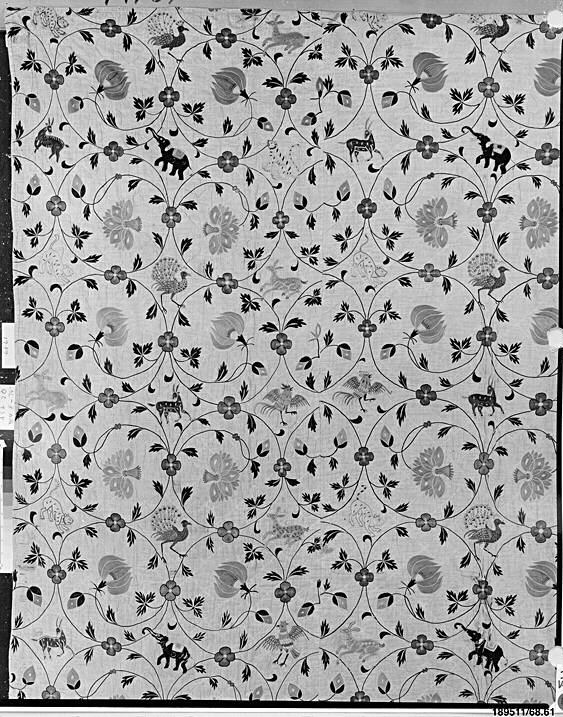Bedcover
Indian, Gujarat for British market
Not on view
During the sixteenth and seventeenth centuries, Gujarat, in western India, supplied embroideries of the highest quality to the Mughal court; these textiles became valued commodities in Europe as soon as sea trade with that region was established. The Portuguese were the first Europeans to enter this market, but most surviving Gujarati embroideries relate to trade with England, which increased in the early seventeenth century.¹
Over the course of the seventeenth century, as the Gujarati embroiderers adjusted their output for the English market, they adopted the common motif of pink flowers detailed in yellow that bloom from dark green vines with light green or yellow veins. In the background are spotted leopards, striped deer, squirrels, birds, and other chain-stitched beasts filled with bands of color or details in contrasting hues. These elements are understood to have been culled from a variety of sources including English embroideries, examples of which must have been sent to India as models (see e.g. Museum of Fine Arts, Boston, nos. 53.2202 and 53.172). But as English embroidery was itself responding to the influx of Asian textiles, incorporating and adapting many foreign motifs, the result was a mix of European, Indian, and Chinese imagery that then fed back to its original sources in a totally transformed state.
This piece, consisting of several panels that have been joined and then quilted to form a bed-size coverlet, includes the motifs found on seventeenth-century coverlets but must have been made in the early eighteenth century, when an overall pattern of rinceaux enclosing flowers became more common.² However, Gujarati production is remarkable for its variety; at the same time, embroiderers were also producing patterns related to French bizarre silks and palampore designs (see e.g. Museum of Fine Arts, Boston, no. 57.168).
[Melinda Watt, adapted from Interwoven Globe, The Worldwide Textile Trade, 1500-1800/ edited by Amelia Peck; New York: Metropolitan Museum of Art; New Haven: distributed by Yale University Press, 2013]
Footnotes
1. For the involvement of different foreign traders in the region, see Irwin, "Indian Textile Trade in the Seventeenth Century: I. Western India," pp. 4 – 33, and Irwin, "The Commercial Embroidery of Gujerat [sic] in the Seventeenth Century," pp. 51 – 57.
2. See also the fabrics in the Victoria and Albert Museum, London (nos. IS 78-1955 and IS 79-1955).
Due to rights restrictions, this image cannot be enlarged, viewed at full screen, or downloaded.
This artwork is meant to be viewed from right to left. Scroll left to view more.



